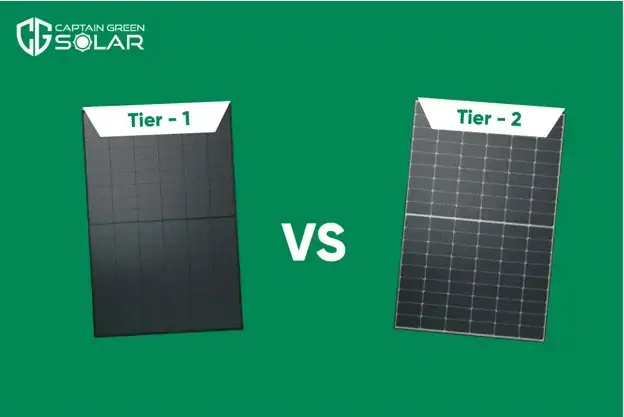ENTER YOUR POSTCODE TO UNLOCK SPECIAL

Choosing the right solar panels for your installation can be a daunting task, especially with the myriads of options available in the market. One of the key factors to consider is the tier ranking of solar panels. This blog aims to demystify the differences between Tier1 vs Tier2 solar panels, helping you make an informed decision.
Tier 1 solar panels are produced by manufacturers that have a proven track record of producing high-quality, reliable products. These manufacturers typically have large-scale production facilities, invest heavily in research and development, and have been in the industry for several years. The criteria for Tier 1 classification are stringent and are usually defined by independent research organizations.
Tier 1 manufacturers are generally large companies with a strong financial background. They have been in the industry for several years, often with publicly traded stock, which provides transparency in their financial health.
These companies have extensive, automated production lines and are vertically integrated, meaning they control most or all aspects of the manufacturing process, from raw materials to the final product.
Tier 1 solar panels are known for their high quality and reliability. They often come with longer warranties (typically 25 years) and have been through rigorous testing to ensure they can withstand harsh weather conditions, making them particularly suitable for Australia’s diverse climate.
These manufacturers usually have a significant share of the global solar market and are widely recognized within the industry. Their products are often used in large-scale solar projects worldwide.
These companies are frequently listed in Tier 1 rankings and are known for their presence in the Australian market.
When choosing solar panels, it's important to consider not just the tier ranking but also the specific needs of your project, the local climate, and the warranty terms offered by the manufacturer.
Tier 2 solar panels are made by manufacturers that might not have the same level of experience or scale as Tier 1 manufacturers. These companies are often smaller, newer, or might not invest as much in research and development. While Tier 2 panels can still be of good quality, they might not offer the same level of reliability or long-term performance as Tier 1 panels.
Tier 2 manufacturers may not have the same level of financial backing or long-term stability as Tier 1 companies. They might be newer entrants to the market or smaller companies with less global reach.
These companies typically have less automation in their production processes and might outsource parts of their manufacturing. This can sometimes result in slightly less consistent quality compared to Tier 1 panels.
Tier 2 panels generally offer decent quality, but they might not have undergone as rigorous testing as Tier 1 panels. Their warranties may be shorter (often around 10-15 years), and they might not be as durable in extreme weather conditions.
These manufacturers have a smaller share of the global market and are less recognized than Tier 1 companies. They might not be used in large-scale solar projects but are still popular in residential and small commercial installations.
These brands are often considered Tier 2 but are still well-regarded in the solar industry. While they may not have the same prestige as Tier 1 brands, they are a viable option for many Australian solar projects, particularly where cost is a significant factor.
| Feature | Tier 1 Solar Panels | Tier 2 Solar Panels |
|---|---|---|
| Manufacturer Scale | Large-scale production | Smaller-scale production |
| Experience | Established companies with many years in business | Newer or less experienced companies |
| Research & Development | High investment in R&D | Moderate to low investment in R&D |
| Warranty | Typically, longer warranty periods (25 years) | Shorter warranty periods (10-15 years) |
| Performance | Consistent and reliable long-term performance | Variable performance; might degrade faster |
| Availability | Widely available and used in large projects | Less widely available; more niche markets |
| Price | Generally higher due to quality and reliability | Generally lower, making them more affordable |
| Bankability | Often backed by large financial institutions | Less likely to have strong financial backing |
Ultimately, the decision comes down to balancing your budget with your expectations for performance and longevity. If possible, consult with a trusted solar installer who can help assess your specific situation and recommend the best option.

Captain Green Solar is one of the Top Solar Companies in Australia. Established in 2010, we are the Trusted Name in Solar for over 14 Years!

Captain Green Solar is one of the Top Solar Companies in Australia. Established in 2010, we are the Trusted Name in Solar for over 14 Years!
